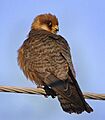Falconidae facts for kids
Quick facts for kids Falconidae |
|
|---|---|
 |
|
| A peregrine falcon at Shubenacadie Provincial Wildlife Park in Nova Scotia, Canada | |
| Scientific classification | |
| Kingdom: | |
| Phylum: | |
| Class: | |
| Order: | |
| Family: |
Falconidae
|
| Subfamilies | |
|
Falconinae |
|
The Falconidae are a family of birds that includes 60 different species of birds of prey. These birds are active during the day. This family has two main groups: the Polyborinae, which includes caracaras and forest falcons, and the Falconinae, which includes falcons, kestrels, and falconets.
Contents
What Do Falcons and Caracaras Look Like?
Falcons and caracaras are small to medium-sized birds of prey. Their size can vary a lot. For example, the black-thighed falconet can weigh as little as 35 grams (about 1.2 ounces). On the other hand, the gyrfalcon can weigh up to 1,735 grams (about 3.8 pounds)!
These birds have strong, hooked beaks and sharp, curved talons (claws). They also have amazing eyesight, which helps them spot prey from far away. Their feathers are usually brown, white, chestnut, black, or grey. Often, their feathers have cool patterns or stripes. Males and females usually look quite similar, though some species have slightly different feather colors or patterns.
Where Do Falcons and Caracaras Live?
Falcons and caracaras live almost everywhere in the world. You won't find them in the very thickest forests of central Africa, some far-off islands, the far Arctic, or Antarctica.
Some species, like the famous peregrine falcon, live in many places. The peregrine falcon can be found from Greenland all the way to Fiji! This makes it one of the most widespread birds on Earth. Other species live only in small areas, like the Mauritius kestrel, which is found only on an island.
These birds live in many different types of places. They can be found in cold tundra, hot deserts, and even rainforests. They generally prefer open areas, but some forest species like to live where the forest is not too dense or at the edges of forests.
Many falcons are migratory. This means they fly long distances between their summer and winter homes. For example, some falcons spend summer in Europe and Asia and winter in Africa. The Amur falcon has one of the longest migrations, flying from East Asia to southern Africa!
How Do Falcons and Caracaras Behave?
What Do Falcons and Caracaras Eat?

Falcons and caracaras are meat-eaters. They hunt and eat other animals. Their diet includes birds, small mammals (like bats), reptiles, insects, and sometimes even dead animals (carrion).
Many people think of falcons as super-fast hunters, and this is true for many of them. However, some species, especially caracaras, are slower and spend more time looking for food on the ground. Forest falcons in South and Central America are good at hunting different kinds of prey in forests.
Some falcons, especially the true falcons, will hide extra food to eat later. They usually hunt alone and protect their own hunting areas. However, during migration, they might gather in large groups. While some falcons eat many different things, others are specialists. For example, the laughing falcon mostly eats snakes!
How Do Falcons and Caracaras Raise Their Young?

Most falcons and caracaras prefer to breed alone. However, about 10% of species, like the red-footed falcon, breed in groups called colonies. They usually have one partner for life. Some caracaras have a special way of raising their young: younger birds (often from a previous brood) help the adult parents take care of the new chicks. This is called "alloparenting."
Falcons generally don't build their own nests. Instead, they use nests built by other birds, or they lay their eggs on cliff ledges. For example, pygmy falcons often nest inside the nests of weaver birds. Caracaras, however, do build their own nests.
Females usually lay about 2 to 4 eggs. The female bird does most of the incubating (keeping the eggs warm). The time it takes for eggs to hatch depends on the species' size. Smaller species' eggs hatch in about 28 days, while larger species' eggs can take up to 35 days. After hatching, the chicks stay in the nest for 28 to 49 days before they are ready to fly. This time also depends on their size.
Falcons and Humans
Falcons and caracaras have a long and interesting history with people. In ancient Egypt, falcons were seen as gods. The god Horus, who was linked to the sky and sun, was often shown with a falcon's head. He was believed to be the ancestor of the pharaohs (Egyptian kings).
Caracaras were also important in the stories of the Aztecs. Today, the caracara is a national symbol of Mexico. Falcons were also very important in the sport of falconry, where people train falcons to hunt. This sport was often enjoyed by kings and queens.
Sadly, these birds have also faced challenges from humans. Some were hunted because people thought they harmed farm animals or game animals. This hunting led to the extinction of at least one species, the Guadalupe caracara. Several island species have also had their numbers drop very low. The Mauritius kestrel, for example, once had only four birds left in the world!
Today, about five species of falcon are considered "vulnerable" to extinction by the IUCN. This means they are at risk of disappearing if we don't protect them. The saker falcon is one of these species.
Images for kids
See also
 In Spanish: Falcónidos para niños
In Spanish: Falcónidos para niños




